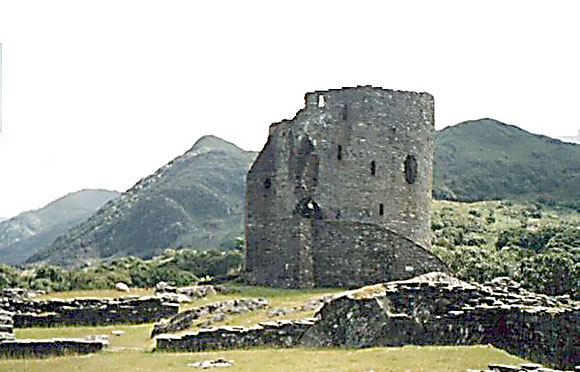Dolbadarn Castle rests on a rocky hillock at the tip of Llyn Padarn, perched above a roadway near Llanberis, in north Wales. It was built by the princes of Gwynedd some time before 1230 and was active through at least 1284.
The castle, a guardpost for the Peris Valley, was built by Llywelyn ap Iorwerth (Llywelyn the Great) at the foot of Snowdon. It stands in a spot of strategic importance, allowing any garrison stationed there to block movement into the hear of Snowdonia. Scholars believe the spot has been occupied by a fortress since the 6th Century, though the surviving stonework can be proved to date back to the 1200s.
Dolbadarn Castle's hallmark feature is a round tower sturdily built of slate and rubble that once stood three stories high, enclosing a complex series of chambers. Today the tower stands just 40 feet tall, but is still girded by walls 8 feet thick. While the castle's flooring has long since disappeared, its interior staircase to the upper story may still be climbed. Scholars speculate that this upper story probably supported hoarding, a type of wooden defensive platform.
Today, only the lowest foundations of the castle's outer buildings still stand. The ruins conform roughly to the shape of a sock, with rectangular towers joined by a curtain wall and a large rectangular hall at one end. There remain two open hearths inside where the hall would have stood.
Though it is not certain, the Tudor antiquarian John Leland, Henry VIII's Antiquarian, asserts that Llywelyn ap Gruffudd used Dolbadarn's tower to imprison his brother, Owain ap Gruffudd during their struggle for control of the kingdom of Gwynedd in the 1250s. Owain spent 20 years as a captive, possibly on the upper floor of Dolbadarn's tower.
Later, during the Welsh wars of independence against the English king Edward I, Dolbadarn Castle was held by another of Llywelyn's brothers, Dafydd ap Gruffudd. But the castle succumbed to the army of the Earl of Pembroke, and in 1283, months after Llywelyn ap Gruffudd, the prince of Wales had been lured into a trap and put to death, Dolbadarn fell to the English army. With Snowdonia encircled, Prince Dafydd moved to Bera Mountain in the uplands above the royal home Garth Celyn. He was captured there in June 1283, taken to Shrewsbury and executed. Within two years the castle was abandoned and its timber used by the English for the construction of nearby Caernarfon Castle.
During the revolt of Owain Glyndŵr, during the 1400s, Dolbadarn's keep may have been used to hold prisoners.
Dolbadarn is now being cared for by Cadw, which also maintains a memorial to the Welsh princes at Dolbadarn. |

